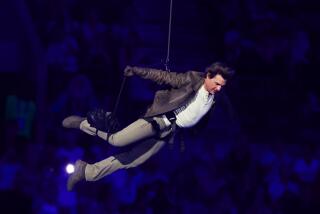WEEKEND OF DIVERSE DANCE : BUJONES SAGS, MORRIS SOARS : An Evening of Stingy Snippets and All-Too-Generous Orchestral Padding
Ballet has never been very comfortable at the Hollywood Bowl.
The sightlines in the gargantuan amphitheater are all wrong. The floor of the sprawling stage was hardly designed for dancing. There are no facilities for scenery. The lighting system is primitive. The stalwart players of the Los Angeles Philharmonic create a distracting background for the dancers, and the poor conductor has to coordinate accompaniment from the rear, as it were.
Still, lofty art has, on occasion, risen above the built-in disadvantages.
In the distant dark ages, the Bowl played host to nearly full-fledged performances by the Bolshoi, the Royal Ballet and the like. Not too long ago, Baryshnikov and members of the New York City Ballet braved the boards.
Friday night it was Fernando Bujones’ turn. The fallen idol of American Ballet Theatre collected five “friends”--colleagues of distinctly dissimilar quality--and mustered an evening of stingy balletic snippets amid all-too-generous orchestral padding.
Although an audience of 9,617 applauded politely, this turned out to be no one’s finest hour.
Bujones gave himself relatively little to do. At the end of the first half of the program, he strutted, turned, twisted and slunk very suavely through the bare-chested indulgences of Maurice Bejart’s Greek Dance.
He was accompanied, incidentally, by Mikis Theodorakis’ folksy diddle-diddle-diddle-diddles on tape. In this context, the tape sounded better than the overworked and overamplified Philharmonic. It gave one pause.
In the second half of the program, Bujones contented himself with the grand pas classique from “Raymonda.” Here he danced with airborne elan that seemed especially dazzling to eyes still smarting from the embarrassment of the aging Rudolf Nureyev’s assault on the same steps in New York.
In what, inexplicably, was her only assignment of the evening, Lesley Collier of the Royal Ballet complemented Bujones discreetly, crisply, daintily and stiffly.
That, as far as the big names were concerned, was that.
The supporting cast included a rough-and-not-quite-ready couple--Maria Teresa del Real of the Pittsburgh Ballet Theatre and Miguel Campaneria of the Ballets de San Juan--plus a nice-and-refined couple--Yoko Ichino and David Nixon of the National Ballet of Canada.
Del Real and Campaneria nearly botched the showy horrors of Asaf Messerer’s “Spring Waters.” There’s no sense going through these empty-headed motions unless one can muster a swift catch and one-armed lift for the final exit. They found a certain degree of bravura charm for the “Don Quixote” pas de deux, but not enough.
Ichino and Nixon fared better. Especially Ichino. Always stylish and thoughtful, she seems to have gained both in authority and finesse since being consigned to an undeserved oblivion by Baryshnikov at American Ballet Theatre.
She is an intensely lyrical dancer, and on this occasion she brought special willowy elegance to the whispering platitudes of a duet from Roland Petit’s awful Marcel Proust ballet, “Les Intermittences du coeur.” She also conveyed the neo-classical brilliance of Balanchine’s “Tchaikovsky Pas de Deux” with striking clarity and nonchalance.
Nixon, her husband, was impressive--if more impressive as a strong, sympathetic partner than as a virtuoso technician.
John Lanchbery conducted the sometimes imprecise Los Angeles Philharmonic with dauntless energy, skill and professionalism. Unfortunately, his duties included lengthy excerpts from “Sylvia” and “Sleeping Beauty” that inspired more frustration than pleasure. While Bujones, Ichino, Collier et al. rested in the wings, Lanchbery did the dancing.
The program magazine, compounding the general bemusement, provided sketchy information about the composers; nothing--repeat, nothing--about the choreography.
More to Read
The biggest entertainment stories
Get our big stories about Hollywood, film, television, music, arts, culture and more right in your inbox as soon as they publish.
You may occasionally receive promotional content from the Los Angeles Times.










